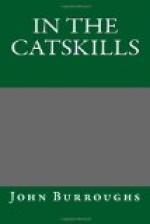Ever since I entered the woods, even while listening to the lesser songsters, or contemplating the silent forms about me, a strain has reached my ears from out the depths of the forest that to me is the finest sound in nature,—the song of the hermit thrush. I often hear him thus a long way off, sometimes over a quarter of a mile away, when only the stronger and more perfect parts of his music reach me; and through the general chorus of wrens and warblers I detect this sound rising pure and serene, as if a spirit from some remote height were slowly chanting a divine accompaniment. This song appeals to the sentiment of the beautiful in me, and suggests a serene religious beatitude as no other sound in nature does. It is perhaps more of an evening than a morning hymn, though I hear it at all hours of the day. It is very simple, and I can hardly tell the secret of its charm. “O spheral, spheral!” he seems to say; “O holy, holy! O clear away, clear away! O clear up, clear up!” interspersed with the finest trills and the most delicate preludes. It is not a proud, gorgeous strain, like the tanager’s or the grosbeak’s; suggests no passion or emotion,—nothing personal,—but seems to be the voice of that calm, sweet solemnity one attains to in his best moments. It realizes a peace and a deep, solemn joy that only the finest souls may know. A few nights ago I ascended a mountain to see the world by moonlight, and when near the summit the hermit commenced his evening hymn a few rods from me. Listening to this strain on the lone mountain, with the full moon just rounded from the horizon, the pomp of your cities and the pride of your civilization seemed trivial and cheap.
I have seldom known two of these birds to be singing at the same time in the same locality, rivaling each other, like the wood thrush or the veery. Shooting one from a tree, I have observed another take up the strain from almost the identical perch in less than ten minutes afterward. Later in the day, when I had penetrated the heart of the old Barkpeeling, I came suddenly upon one singing from a low stump, and for a wonder he did not seem alarmed, but lifted up his divine voice as if his privacy was undisturbed. I open his beak and find the inside yellow as gold. I was prepared to find it inlaid with pearls and diamonds, or to see an angel issue from it.
He is not much in the books. Indeed, I am acquainted with scarcely any writer on ornithology whose head is not muddled on the subject of our three prevailing song-thrushes, confounding either their figures or their songs. A writer in the “Atlantic"[1] gravely tells us the wood thrush is sometimes called the hermit, and then, after describing the song of the hermit with great beauty and correctness, coolly ascribes it to the veery! The new Cyclopaedia, fresh from the study of Audubon, says the hermit’s song consists of a single plaintive note, and that the veery’s resembles that of the wood thrush! The hermit thrush may be easily identified by his color; his back being a clear olive-brown becoming rufous on his rump and tail. A quill from his wing placed beside one from his tail on a dark ground presents quite a marked contrast.




